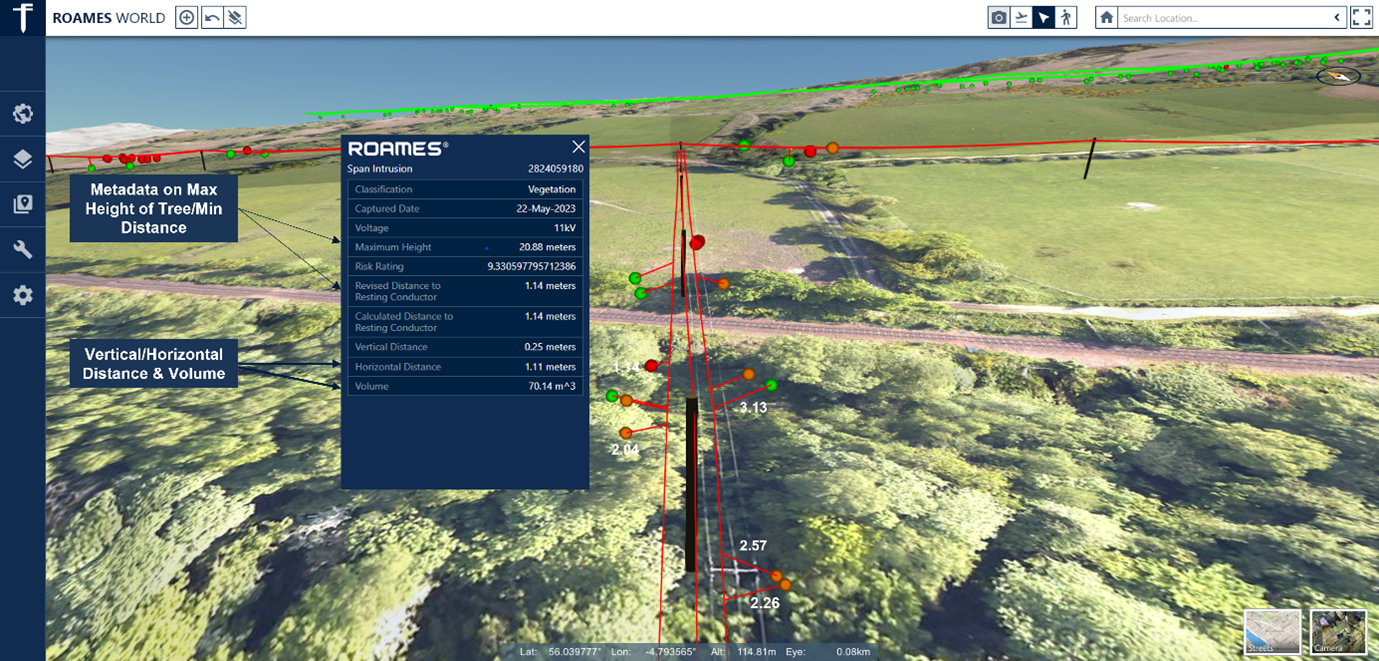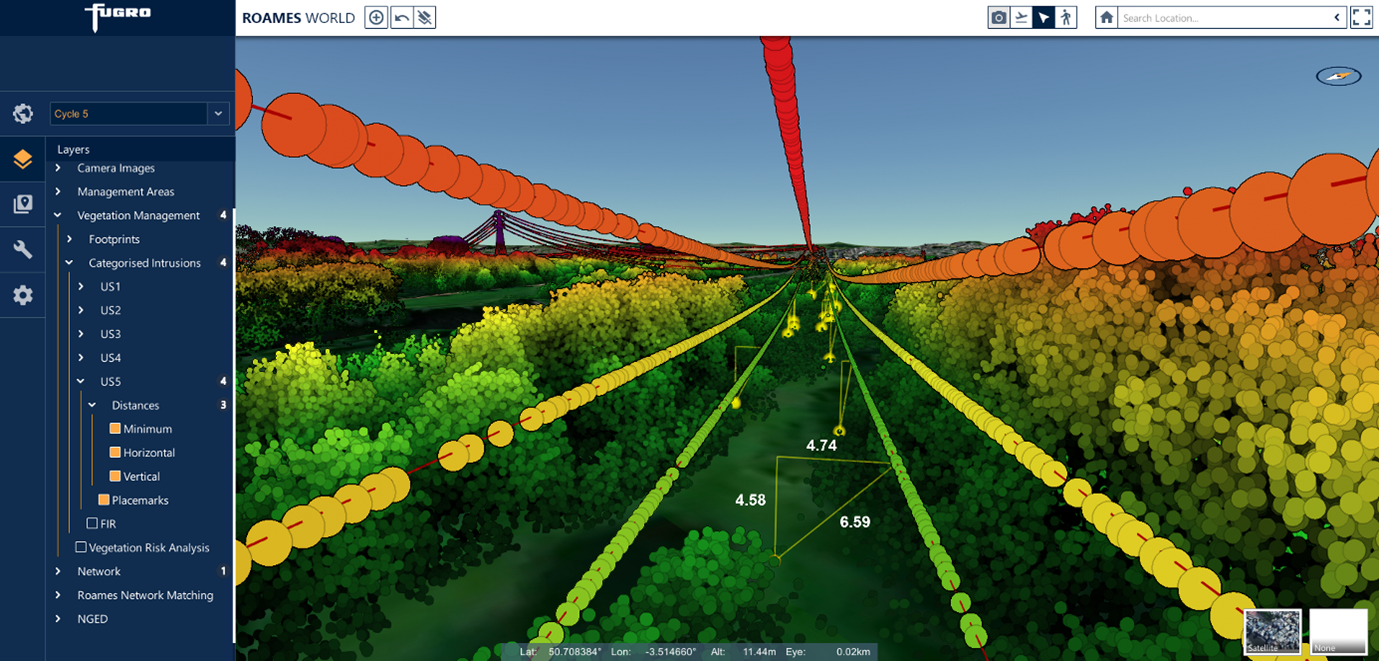Fugro: Digitalisation of Clearance Monitoring to Maintain Regulatory Compliance
Our goal is to help DSOs build and maintain a digital asset library by transforming remote sensing data into a spatial digital twin of the world. This solution is called Fugro ROAMES® and follows the principle of map, model, monitor. Having acquired the Geo-data (map) our solution models the assets in 3D while also modelling the environmental features (vegetation) just like assets, generating analytics about these modelled features. These analytics are converted into insights that will improve monitoring and maintenance programmes across our clients’ network. The DSO we are working with is SP Energy Networks, whose parent company is Iberdrola.

Photo Credit - Courtesy of Fugro

Digitalisation Solution or Approach: The case study provides a specific digital solution for vegetation inspection and management. However, there are several ancillary solutions that it provided to other parts of the DSO particularly in asset management. This included GIS conflation, identification of pole lean, low ground clearances, structural infringements and network capacity modelling.
Objectives: This removed as much as the field inspection process from vegetation management allowing DSOs to make faster and smarter decisions on their network by prioritising the most at-risk parts of their network and building optimised vegetation programmes based on the reduced resources available within their organisation.
Context, Challenges, and Framework
Industry Landscape: Climate change and a reduced and aging work force are putting a huge amount of pressure on DSOs and their vegetation and asset maintenance programmes. Increased growing seasons and/or hotter and drier climates increasing the threat of wildfires are already being seen across Europe. This rapidly changing environment will need DSOs to adopt new digital technologies such as remote sensing to provide a holistic view of their entire network and its current state to help drive new maintenance programmes that will be able to keep up.
Roadmap (Accenture’s framework for digitalising DSO activities):
- DSO Activity: Maintain. Asset Data Management/Asset Portfolio & Risk Management/Vegetation Management
- Digital Maturity Level: Leading
- Software as a Service
Specific Challenges Addressed: Aging Assets/Improved vegetation management/improved design and engineering/improved GIS records/capacity modelling
Solution Overview
- Technological Definition: Digital Twin. Drones and Robotics. Asset Management, Tools and Procedures
- Solution Description: Network mapping using remote sensing technology. Modelling of the network using AI and ML algorithms to automate and speed up the delivery process. Monitoring of the network using 3D visualisation tool and online analytics all hosted on cloud services.
- Technological Components: Remote sensing technology including lidar and imagery. AI and ML harnessing cloud edge processing technology. Monitoring of the network using 3D visualisation tool and online analytics delivered using gaming technology.
Implementation Details
- Phases: Pilots completed and solution has been implemented by numerous DSOs across the world.
Functionality and Users
- User Roles: Asset Managers, Grid Planners, Field Engineers, GIS Specialists, Vegetation Managers, Transmission Engineers

Photo Credit - Courtesy of Fugro
Key Performance Indicators (KPIs)
- Efficiency and Reliability Improvements: Metrics related to the improvement of processes, efficiency, and reliability across the DSO’s activities:
-
- Client organisation has been able to reduce their high-risk vegetation spans across their network to less than 5% over three years by having a targeted approach to their cutting programme.
- Client has reduced their eight-year vegetation cycle to a three-year programme saving significant time and reducing risk across their network.
- Client has moved towards a predictive maintenance cycle with their vegetation programme, however, it does require more information such as tree species and health which is what we are currently working towards.
- User Satisfaction: The ability to visualise the network in a digital environment without having to visit the asset in the field has provided their asset and vegetation management teams with faster decision-making time. The GIS team have been able to improve their records overall and reduce the number of false positive callouts to the wrong assets. The vegetation team can desktop assess their spans before ensuring the right equipment is deployed.
- Achievements: Fugro ROAMES® won the Utility Network “Game Changer” Award in 2019 for our work with UK DSOs.
Lessons Learned and Best Practices
- Key Takeaways: Needs buy in from the business units. DSOs need to engage not just the business unit but the policies and standards teams within the organisation. Engagement with the regulator is also beneficial as with this service they can start to provide evidence of the vegetation intrusions around their network and how much it will cost to remediate.
- Best Practices: Always start with a good-sized pilot project to help define the business rules and the insights required. Engage the business units early to generate ownership in the procedures and processes. Ensure policies and standards are updated in line with the new protocols around the inspection processes.
- Scalability: Fugro ROAMES® workflow employs high levels of automation, artificial intelligence and stringent quality control processes. These processes are executed on our scalable, cloud deployed ROAMES® data processing platform. On average, our platform computes 230,000+ hours per month, publishes 250,000+ spans and 20,000 network kilometres. This equates to 250,000+ kilometres of powerline and trillions of data points processed on an annual basis.
Conclusion
- Summary: Our client has seen their inspection programme decrease by more than 50% allowing better insights across the network. It has also reduced the number of false positive visits and the teams do not have to visit every span, only those with vegetation present. This has allowed them to engage new cutting programmes and cycles ensuring better network resilience and customer satisfaction.
- Actionable Insights: Be prepared to find out the level of vegetation infestation across your network. This will generate a lot of talking points around programme optimisation and priorities. Not everything will be fixed all at once so need to work with both the business units and regulator.
Call to Action:
- Video link: Fugro ROAMES® Reducing maintenance costs across your network (vimeo.com)
- Website and links to more information Assess, monitor, and maintain your powerline network | Fugro
- Social Media: https://www.linkedin.com/showcase/fugroroames
Disclaimer: This material is Fugro’s property and is herewith provided by Fugro for the sole purpose of the webpage Fugro: Digitalisation of Clearance Monitoring to Maintain Regulatory Compliance in advance of the Eurelectric Summit event on 22-24 May 2024. For further or different purposes, please contact Serge van de Ven, Director of Brand & Communications at Fugro, to seek renewed written authorisation. Fugro holds all copyrights to the materials content. All Intellectual Property Rights remain vested in Fugro. The present authorisation does not extend to modifications of the materials. The materials and the operations of these terms and conditions shall be governed by the laws of The Netherlands. The courts in The Netherlands shall have exclusive jurisdiction over any dispute arising out of the use of this website.